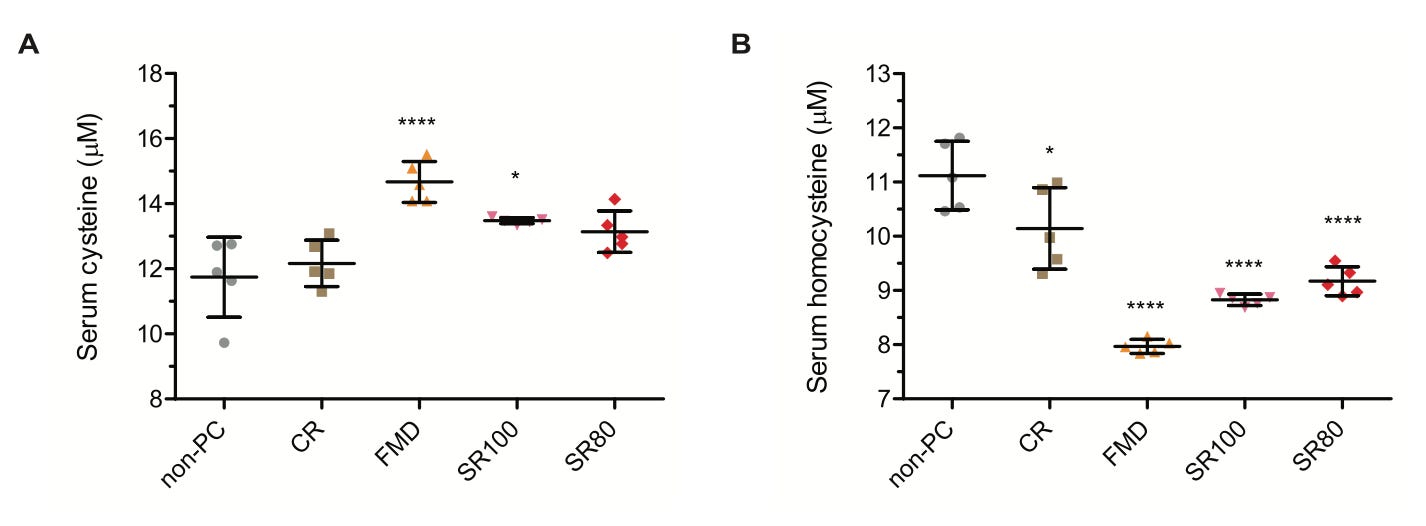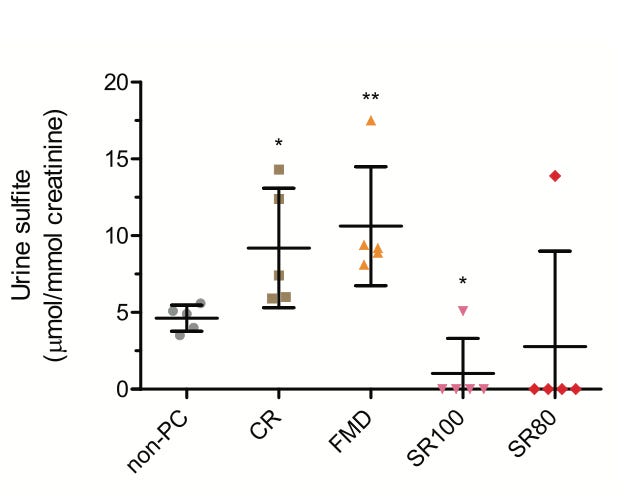Will Longevity Diets Wreck Your Hormones?
Without the right nutrients they might even shorten your lifespan!
One study in mice compared standard lab chow to calorie restriction, a fasting-mimicking diet (FMD), a ketogenic diet, a diet low in branched-chain amino acids (BCAAs) and two diets that restricted sulfur amino acids (SAAs) by either 80% or 100%.
Some of these diets made the mice more likely to die.
Many of them protected the kidneys of the mice, but at a cost: one that could raise anxiety, tank testosterone, drive estrogen-mediated nausea and itchiness, hurt sleep, cause neurological and pyschiatric disorders, and in the long-run probably shorten lifespan if the right nutrients aren’t in place.
The goal was to look at the ability of these diets to protect kidneys from damage during a process known as ischemia-reperfusion injury. In this process, they anesthetize the mice with ketamine, take out their right kidneys, restrict blood flow of the left kidneys until they turn white, then allow blood to flow again and sew the animals back up. One or three days later, they sacrificed the animals and examined their kidneys to see how much damage there was.
Their goal was to use diets that would “activate longevity pathways” in order to lead to “an increase in cellular and organismal stress-resistance.” They considered “acute kidney injury” to be “an important aging-associated disease” because it predisposes to chronic kidney disease, which is a driver of mortality. Calorie restriction has previously been shown to protect against acute kidney injury in rodents, but it is difficult to get kidney patients to embrace calorie restriction, so they were hoping that one of the other alternatives would be just as protective.
The FMD consisted of alternation between standard chow and a limited diet of essential micronutrients, broth, vegetable powder, and extra virgin olive oil. The ketogenic diet was 89% fat, 10% protein. The low-BCAA diet restricted leucine, isoleucine, and valine by 66%, and the low-SAA diets reduced methionine and cysteine by 80% or 100%. The diets were fed for two weeks prior to inducing kidney injury.
As can be seen below, restricting BCAAs made the mice far more likely to die in the first three days after injury. The ketogenic diet considerably outperformed the controls, but the other diets fully prevented death within three days after injury.
Creatinine builds up in blood when the kidneys are too injured to release it into the urine. The creatinine suggested that every diet protected the mice except the ketogenic and BCAA-restricted diets.
By examining the circles representing individual mice, the keto diet obviously had a bifurcated effect where half the animals lived and had lower creatinine than controls, but not as low as animals on the more protective diets, and the other half did not receive any protection and died.
Presumably the BCAA restriction killed the mice by lowering mTOR stimulation, which is needed for all healing. The other diets probably diet not lower mTOR sufficiently to have this effect.
Since sulfur amino acid restriction was very effective, and since it has previously been shown that calorie restriction increases hydrogen sulfide production whereas sulfur amino acids counteract this effect, the researchers looked at the role of hydrogen sulfide-related pathways in mediating the kidney protection.
All these further analyses excluded the ketogenic and BCAA-restricted diets.
All of the successful diets increased the breakdown of homocysteine to cysteine as judged by serum values:
In the case of the SAA-restricted diets, it is more likely that this reflects catabolism of body tissues, because the expression of the enzymes that mediate the breakdown of homocysteine to cysteine were decreased rather than increased, and the zero-SAA animals lost bodyweight during the study.
Calorie restriction and the FMD increased urinary sulfite:
By contrast, the two SAA-restricted diets primarily elevated urinary
S-sulfocysteine:
Most likely during SAA restriction, cystine, which is composed of two molecules of cysteine bound together in a disulfide bond, is released from body tissues. Sulfite then reduces half of the cystine to free cysteine, and converts the other half to S-sulfocysteine. This will allow the release of cysteine to compensate for the dietary deficiency.
Since the authors were more interested in general hand-waiving about “longevity pathways” and “organismal stress-resistance,” it was sufficient for them to invoke evidence that calorie restriction lengthens lifespan by increasing hydrogen sulfide; therefore, the increased hydrogen sulfide — evidenced by elevation of its degradation products in the urine — must have activated “organismal stress-resistance” that protected the kidney from harm.
The ridiculousness of this approach is seen by their need to completely gloss over the death produced by their mTOR-inhibitiing strategy without any meaningful comment.
So, let me try to explain this:
Hydrogen sulfide is a vasodilator, like nitric oxide.
When you restrict blood flow, being able to quickly and maximally vasodilate determines whether you can recover from the hypoxia induced by the restriction.
This general capability is tested in humans using restriction of the forearm artery and watching with an ultrasound how wide the vessel dilates when the restriction is removed to allow the blood to rush back in. The procedure is called measurement of “flow-mediated dilation” and is considered a metric of “endothelial function.” Declines in this metric are a very early predictor of cardiovascular disease.
Increasing the demand to break down cysteine will prime the enzymes that do this to be able to react quickly when the demand to increase blood flow quickly suddenly has its stakes raised to be a matter of life-and-death over a 72-hour period.
Breaking down cysteine to hydrogen sulfide often forms pyruvate as a product. The pyruvate can be used to make glucose and glycine during periods of carbohydrate restriction. When you eat carbohydrate, you get pyruvate from breaking down glucose, which inhibits the enzyme that produces it during the conversion of cysteine to hydrogen sulfide.
It seems to me that these diets are imposing demand for pyruvate for two weeks in order to obtain the incidental benefit of improved vasodilation in response to acute kidney injury.
While it works, it isn’t obvious that it’s the best tool for the job. The most broadly healthy way to train blood flow is to exercise. Preconditioning with exercise protects against ischemia-repurfusion injury in rodents and wasn’t compared to these diets.
It is definitely not the case that hydrogen sulfide is generally protective to the kidneys in any quantity. There are coenzyme Q10 synthesis disorders whose sole manifestation is kidney damage, which is mediated precisely by decreased clearance of hydrogen sulfide in the kidney. This is probably because hydrogen sulfide inhibits the mitochondrial respiratory chain and numerous enzymes in fatty acid and amino acid oxidation.
The real downside of the “longevity diet” approach is the sulfite and S-sulfocysteine.
Sulfite can degranulate mast cells, causing pseudo-allergies, and it binds to cysteine, forming S-sulfocysteine, which is a neurotoxin that activates NMDA receptors and can thereby cause seizures, episodes of hypersensation, chronic pain, anxiety, tremors, jerky movements, sleep loss, anxiety, irritability, and distractibility, with extreme variation in the neurological manifestations and the very likely ability to massively aggravate any underlying neurological or psychiatric condition.
As I covered in The Unknown Testosterone Nutrient, sulfite tanks testosterone and destroys male fertility.
In women, it mediates the effects of estrogen on allergy-type symptoms, sleep loss, nausea and vomiting, and in some cases in pregnancy drives thiamin loss to the point of causing hallucinations.
Most likely, sulfite actually shortens lifespan.
Whether ketogenic diets raise sulfite or S-sulfocysteine levels remains to be seen. Acetoacetate, but not beta-hydroxybutyrate, inhibits a second enzyme capable of generating hydrogen sulfide, which might counteract the loss of pyruvate activating the other enzyme. Most likely the pro-GABA effects of ketones would counteract the pro-glutamate effects of S-sulfocysteine, and this is supported by the efficacy of ketogenic diets for seizures.
In all cases, supplying glycine should reduce the demand for pyruvate, and counteract to some degree the pressure that glucose deprivation places on the need to breakdown cysteine.
Regardless, the elevation of urinary sulfite suggests that the requirement for molybdenum was increased.
These results underscore the need to add liver to your keto diet, the need to add legumes to your calorie-restricted or fasting-mimicking diet, and the need not to get up in waving around longevity slogans at the expense of science.
Further, they underscore why you should never, ever, ever, ever, ever assume your blood sugar is low if you get anxiety between meals unless you measure it, or unless you have repeatedly measured it and shown that your intuition about your blood sugar is a useful proxy for your actual blood sugar. It could easily be the case that you are generating neurotoxic S-sulfocysteine generating your anxiety when you haven’t eaten. Your feelings are your feelings and your biochemicals are your biochemicals.
The Sulfur Protocol
Click below to get my Sulfur Protocol:









I tried green lentils (molybdenum) for the first time in my life this past week (I’m an adult). Felt euphoric the first day and still good the next. I’ve been eating lots of protein for the past few years. Thanks for the tip!
I just recently read a paper where threonine restriction alone was significant in stimulating ...hepatoprotectivity. Also tryptophan. BUT again, MOUSE study. You seem confident that the biochemical explanation is sufficiently analogous to the human...but I notice you didn't make any qualifying remarks about how well the results actually would translate. In fact, you seem to cast doubt that methionine restriction per se is of any value! I guess I still have a lot of reading ahead of me on this subject, b/c that's news to me